|
|
Welcome to my travel log! You will find here a lot more than in the travel reports, stripped from political correctness. Enjoy! 
Dec 21, 2003 07:00 PM Cambodia - Angkor
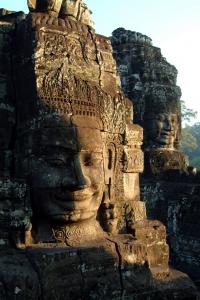 The jungle, as it is said on many occasions, claimed many of the Khmer temples, including a few in the Angkor area. The trees climbing on the ancient structures look spectacular and become the most photographed plants in the country. I was one of the visitors who could not resist the temptation of taking pictures of the jungle invading the sacred temples, making its home or rather reclaiming what was taken from it millennia ago. It is like revenge.
The jungle, as it is said on many occasions, claimed many of the Khmer temples, including a few in the Angkor area. The trees climbing on the ancient structures look spectacular and become the most photographed plants in the country. I was one of the visitors who could not resist the temptation of taking pictures of the jungle invading the sacred temples, making its home or rather reclaiming what was taken from it millennia ago. It is like revenge.
It looks like the government of Cambodia decided to fight for some of the more important (how the importance is determined, is a mystery to me) temples and monuments and gave up long ago with other areas. Ta Prohm was one of the most important temples in the Angkor times, but it has been famously left to the jungle to swallow. Quite unbelievable and very spectacular!
It is the largest temple in the world. There is no doubt about that. When I saw Angkor, I thought I was impressed. That was however before I realised how large the area with all the temples was, and how long it takes to visit the temples.
Angkor is often referred to the single, and the largest, temple of Angkor Wat. This is not entirely accurate, because it seems that the an area a lot large is Angkor. And I heard people referring to the entire area as Angkor Wat. I think this is because Cambodia had been for many years off limits for tourism and people just never had the convenient opportunity to get it right.
I started visiting Cambodia from Angkor and the related temples. Right from the airport in Siem Reap I was taken on the back of a moto to town and it was still before 8am. For one US dollar, I ordered to take myself to Victory Guesthouse, which my friends recommended to me for its good location, inexpensiveness and good conditions.
I simply dropped my bags, took a quick shower and went straight back on the same moto to the Angkor temples. Even then, I had no idea what to expect. I was so unaware. I was totally unprepared to see nine temples in one go. Funny enough I did not even see the most famous one – Angkor Wat – until the very end of my day.
I started with the Bayon. This one has become my favourite of the all temples. By far! It is a materialisation of a fairytale temple, located deep in the jungle, covered with mysterious carvings of unknown faces. Ruined, and left to the jungle to own. To the jungle and to the monkeys and snakes. This is what the Bayon exactly is. It has 216 mysteriously smiling faces of an unknown person, situated on 54 towers. Each tower containing four faces. A perfectly symmetrical wonder! There are no words to describe it.
It has three levels. To each level steep stairs lead and each level contains its own mini temples. The higher one goes, the level is smaller, but equally astonishing. The steps are so steep with very small room for feet, that I eventually did not climb the highest level. It is less difficult to climb up, and the real trick is to get down. I decided not to risk my photographic equipment on the first day of the holiday. You can imagine me trying to keep control of my feet sliding down on a eight-hundred-year-old temple with a five-kilogram-heavy digital SLR camera.
I visited Bayon more than once, and the best time was right after the sunrise, when the sun was systematically and slowly illuminating the smiling towers. The faces are enormous, a lot larger than real life size. I put the picture of them at the Cambodia’s title page, a few pages back.
Sunrise is best also for the fact that there are few people on the temple and you can wander anywhere in the complex feeling like you are there on your own and that the morning belongs to you and the temple only.
One can spend entire day just in the Bayon, soaking the ambiance of the place, examining each tower in detail, looking each face in to the eye. The smile is on the face is unforgettable! It is subtle, warm, cheeky, happy – all in one. It is as incredible as da Vinci’s Mona Lisa’s smile.
I cannot explain the magnetism of this place. It is equally mysterious as the temple itself. It is mind-boggling that to date, it has not been established whom exactly the faces represent.
|
Dec 21, 2003 07:00 PM Cambodia - Temples of Angkor
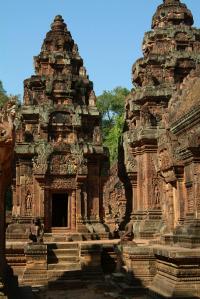 I got up at 5:30am and set out again. This time I had a plan. I wanted to see almost everything. And not on the back of a motorbike! The strategy was to find a tuk-tuk, a motorised sofa or rather sofa attached on a haul to a motorbike - with a little roof for sun and rain protection. Brilliant if you don’t care moving slightly slower than on a bike as you can take pictures from a perfectly seated position.
I got up at 5:30am and set out again. This time I had a plan. I wanted to see almost everything. And not on the back of a motorbike! The strategy was to find a tuk-tuk, a motorised sofa or rather sofa attached on a haul to a motorbike - with a little roof for sun and rain protection. Brilliant if you don’t care moving slightly slower than on a bike as you can take pictures from a perfectly seated position.
So, the plan was to walk to the town of Siem Reap and find a guy with a tuk-tuk. It actually did not take me long at all. I let a guy to accidentally speak to me and offer a ride. There were actually two of them, of which I chose the poorer looking one – later I realised he did not have right leg. I agreed a price – USD 10 for the entire day!
I made me feel happy and angry at the same time. Happy because it was so cheap and angry because for two thirds of a day on a moto I paid twice on the day before! Well, I was on holiday, so I did not really care.
The tuk-tuk guy had a map of the area attached to his tuk-tuk. It was brilliantly convenient, because it was large and clear and it meant that I did not have open my guide book every now and again and it was easy to point on the map where you wanted to go.
The map contained the two routes of the Angkor area – long (red + green) and short (red). These two are the most popular options and are unfortunately recommended in every book making it a routine and squaring up the tourists.
When I showed to him that I wanted to go to Bantey Srei as well, some 18 kilometres beyond the main Angkor area, he asked for more money for petrol. I told him, that everything was going to be fine, and he should not worry about his fee.
He was so happy, that he actually showed me a lot more than I myself planned to see – I had no idea what to see – all I had was my guidebook.
He took me to one of the better-preserved temples, which actually has become my second favourite – the Banteay Samre. It is outside the recommended routes, less crowded with tourist and it is beautiful. It did bring me to my knees. I am not lying!
Let’s put the day in a more chronological order though. The day looked like this: The Bayon, Ta Prohm, Banteay Srei through villages - highlight of the day, Banteay Samre, Prey Prasat, Preah Khan, Preah Neak Pean, Eastern Mebon - one with the elephant statues, hot air balloon, and Angkor Wat for the sunset again.
I knew from the day before that I wanted to see Bayon again. And at sunrise! It was well before 7 am and the sun was just about getting above the trees. It started illuminating the temple slowly and steadily. What a way to start a day!
The next stop was Ta Prohm as I wanted to see it in a different light. However, it was on the way to the temple of Banteay Srei. The way was leading through villages, which was the highlight of my day already. I was so excited to be able to see the real Cambodian life. Not the touristy and commercialised, but genuine and every-day life.
I saw housewives going about their business, making up their households, organising things, cooking, despatching kids to school. I saw kids walking to school, some of them cycling. I saw kids in the school or actually in the schools’ yards. I saw people working in the rice paddies and walking the cattle. I sometimes stopped and talked to the kids. It was brilliant. This 18 kilometre trip felt like a day trip – so much was happening.
Banteay Srei is told to be the most decorated temple in Cambodia with the most sophisticated carvings. It is actually true. Unfortunately it does not help being located outside the main Angkor area, because tourist groups despatch themselves in coaches and one can imagine how crowded it gets.
There has been some conservation being done when I arrived and a group of locals dressed in working suites were doing something to the main temple path. I actually could not figure out what they were doing exactly, but what I could figure out was that it was most definitely government work. The guys were moving very slowly, almost like it was in Africa, where time does not matter. Most of the time, these guys were just sitting down and pretended they doing something. What in fact they were doing was nothing.
It reminded me of the socialistic times in my fatherland (motherland?), where it did not matter how long it took to do something. At ends of the day, it had to be done – because that was the plan.
UNESCO, who most probably give some money for the renovation and maintenance of the temples, must be very brave of letting the money flow for the hourly paid work.
Well, Banteay Srei is magnificent. I wanted to take picture from any possible angle. The problem was that my lens was not a wide angle and the temple would not fit on the picture like I wanted. For sure, people who built it must have had great fun of carving all these elements. So finicky and detail, that it is hard to imagine how long it actually took to do all this. Entire temple walls and frontals are covered in carvings of gods and goddesses.
The temple is also of an unusual colour. It is rusty-red, and compared to all other grey-green temples, it stands out.
After having had a look at the temple, I decided to have a drink and maybe try something for breakfast. There was an eatery right opposite the outer walls of the temple. It looked reasonably clean so I thought I should sit down and see what happens. I invited my tuk-tuk man.
|
Dec 20, 2003 07:00 PM Cambodia - Siem Reap and Angkor
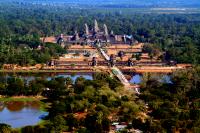 Small airplane – ATR 42 was a surprise. I thought there would be more passengers travelling to Cambodia’s prime tourist attraction. Well, the service was professional and the trip was short.
Small airplane – ATR 42 was a surprise. I thought there would be more passengers travelling to Cambodia’s prime tourist attraction. Well, the service was professional and the trip was short.
Another advantage was that the aircraft was not flying as high as the jets are and the views were amazing. As amazing, as the jungle can be from the air.
Just before landing, some 15 minutes before touchdown, the view became incredible. Cambodian jungle appeared like a vast flat area of swamps. I am a silly bagger that I have not taken the picture of it.
Every now and again there were villages and acres of possibly rice paddies surrounding them. People on boats traveling through dense grass and possibly mangroves were an attractive addition to this holiday view. I am not sure whether those were mangroves, I could not see that closely from 15,000 feet above the ground.
Later, when I actually went into the jungle I found how dense it was actually. Well, on many films one would see quite a more dense jungle. Nevertheless, something tells me that I just did not have the opportunity to see the heart of the jungle. I would imagine that those parts were not accessible and even if they were, the landmines would most definitely prevent me to go there.
These parts I could see where nice. Not as nice as the jungle on Madagascar, but Madagascar exceeds any scales of the fauna beauty on this planet. Naturally!
In Cambodia, the jungle enjoys lush bush-like plants and massive tall trees. The gigantic fern trees are also quite popular and the palm trees add to the overall Asian flavour. In the jungle it is dark and very little sunshine reaches the ground. That is no surprise at all, in fact.
What was surprising for me however were the falling leaves. I did not expect the leaves to fall there at all. But this is what was happening all the time. The leaves are quite large and when hitting the ground they make a sound that may be confused for an approaching animal. That is what stimulates imagination. It is a good holiday feeling. This is what I think anyway.
In the UNESCO and national parks, there are entire armies employed to tidy up the tracks and sweep the leaves away. I mean one army of people per each alley, without unnecessary exaggeration. I suppose this is good for the people as they find employment this way. This is not good for the country though, as it should attract investments that create employment rather than hiding unemployment through over employment. But who am I to tell them that?
|
Dec 19, 2003 07:00 PM Indochina - a first true glance at Asia
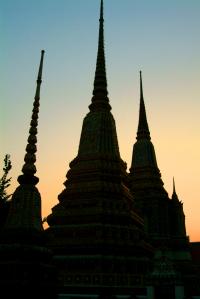 The route for Indochina was growing on me for several months, as I could not quite decide where to go exactly, or worse, for how long.
The route for Indochina was growing on me for several months, as I could not quite decide where to go exactly, or worse, for how long.
It took a few weeks to study seven guidebooks from three different publishers plus numerous websites before I could sketch an itinerary.
Then, of course, talking to the people who actually went to Indochina messed up my sketch several times and my Excel spreadsheet was overheating badly.
The greatest dilemma was the length of stay. As I had my ticket to Bangkok for nothing but loyalty airmiles with Star Alliance airlines, I could change the returning date on the ticket with no problem. I was originally planning to cover a lot of area within three weeks and was wondering whether it was actually wise to push for that. It would only mean rushing from one place to another with no room for relaxation. What kind of holiday would that be?
The number of countries and the actual length of stay in them was the main decision variable, which was impacting the entire plan. There were a few prerequisites. I wanted to be in more interesting places for the following days: 24 Dec, 31 Dec and 5 Jan.
Finally, I decided to do very little in Thailand with the plan to visit it properly in the future and spend the largest number of days in Vietnam.
|
Oct 02, 2003 02:00 PM Crete (GR) - Chania
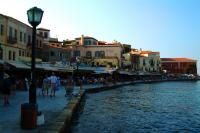 Fortunately, Chania was attractive enough for us to make up for the previous hit-and-miss (definitely miss) places.
Fortunately, Chania was attractive enough for us to make up for the previous hit-and-miss (definitely miss) places.
Chania used to be the capital city of Crete. Its history dates back to the Minoan times. Then, it was known as Cydonia.
When the civilisation collapsed, following the eruption of Thira and the conquest of Crete by Mycenaeans around 1450 BC, the city quickly re-gained importance as a major harbour. It flourished during the Hellenistic, Roman and Venetian times.
When the Venetians took Cydonia in the thirteenth century, they renamed it La Canea and completely rebuilt it. They erected several fortresses and strongholds. The city harbour gained new shape and edifices around it. The majority of them still stand there. This makes Chania among the most attractive places to see on the entire island.
Fortunately, the tourists tend to stay in many of the concrete hotels outside Chania itself, which makes it somewhat calmer than the number of visitors would suggest. This is great, because this makes quite easy to get a table at one of the Old Harbour restaurants without booking.
The old town of Chania is just a maze of narrow streets lined up with old Venetian houses, which have been restored with a little help from the European Union. The streets are atmospheric and although many of them are just stretched shopping centres, it is pleasant to wander around them. The many boutiques and petty shops nicely blend with the old Venetian architecture.
One you are wandering around those narrow alleys, no modern building can be seen. This is great for a holiday in an historic town, which creates an aura of mystery, almost, and a thought that those edifices must have seen a lot in their lives.
The old Venetian port in a circular shape is also a great spot. I could just sit there on a wooden bench, close to the water and marvel at the grand buildings reflecting in the clear waters of the harbour. Or better yet, sitting at one of the tables belonging to one of the many bars and restaurants there, and drinking cold beverages. Or even having seafood dinner when the port’s lights gently illuminate the remarkable architecture, and the music of from the restaurant adds to the overall mood.
Well, apart from exploring the old town and sitting at the picturesque harbour, there is not an awful lot to do in Chania. Not in the historical district, anyway. And I mean that shopping is not an activity in the holiday standards. According to my rules and principles, of course. But letting myself go and seeing the town, taking pictures and watching people are definitely my favourite ways of exploring the places and being on holiday. So, this is not a complaint! Yet, I was there with my friends and I thought that it would be great that they could do whatever they liked to do on their holiday.
There is a beach nearby, where people are lured to spend some of the money on water sports. However, there is nothing special about it. Water sports like those over there can be done anywhere in the world. They did not have Chania character.
And then, we discovered submarine trips. Well, semi-submarine trip, as the boat did not go under water completely at any time. It was not designed to do so, in fact. Instead, it had large windows and seats below the waterline.
The company was promising an unforgettable and great experience. Pictures on their posters presented the abundant sea world, full of colourful fish, some of it large, beautiful and some wonderfully scary. The cruise map suggested the boat was going far away from the shore.
A good looking Italian skipper kept luring gullible tourists to come on board for this spectacular and superb trip. It turned that it was all a lie a -typical tourist trap.
The yellow semi-submarine, extremely hot inside, was cruising in small circles some five meters from the harbour. What one could see from the windows was laughable. I actually took a picture and present it above. It was very hard to see anything at all! The fish was small and unremarkable. The light from the surface was too weak to reveal any colours. It did not matter anyway as I seriously doubt any of the fish had more than one colour on their scales.
The fact that the vessel did not go very far was easily discoverable. For the reason that someone may suddenly feel claustrophobic, it was allowed to come up from the deck below the waterline and sit on the top deck. As soon as the captain allowed you up there, it was clear how close to the harbour the boat was hoovering. What a scam!
Well, anyway it is now something to write about.
|
Oct 01, 2003 02:00 PM Crete (GR) - Myrtos, the car crash!
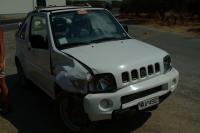 We stopped in Myrtos for a quick breakfast. The guidebook suggested it was a nice village with great beach and a relaxed feel. Perhaps it was. I could not see anything special about it actually. Yes, it was orderly, its streets based on a grid. The whitewashed little houses added a pleasant ambience to it all.
We stopped in Myrtos for a quick breakfast. The guidebook suggested it was a nice village with great beach and a relaxed feel. Perhaps it was. I could not see anything special about it actually. Yes, it was orderly, its streets based on a grid. The whitewashed little houses added a pleasant ambience to it all.
Access to the beach was rather awkward and the eateries at the beach lost their authentic ambience to accommodate the international traveller. Many small restaurants were specialising in the traditional English breakfast infested with baked beans, bacon, fried eggs, greasy toasts, pork sausages, mashrooms and cooked tomatoes! I could not believe what I was seeing. It was so terrible that I actually do not want to remember the signs or the smells!
We were out of there in no time. It was my turn to drive. Well, I did not enjoy it for a long time. I stopped at one of the petrol station to take some fuel and wizz in the staff’s restroom. Ten minutes after that I crashed the car. Not completely, but we could not continue our journey.
As I was driving downhill on a straight road, a car in the front of me was driving very slowly. I decided to swiftly overtake it. As I was beside it, almost half of its length, its driver decided, without any warning or indicating, to turn left into an unsignposted side road. It suddenly swivelled towards the middle of the road right in front of me. As I was then travelling at a higher speed, I decided to avoid the collision and escape farther to the left.
My braking did not work, as the tarmac was covered in sand spread from a heap of sand left by the side of the road. At the rural crossing, I wanted to escape to, there were two cars standing, whose drivers kept chatting to each other. Just like that. Parked at the crossing and talking.
I smashed into the back of one of them. The impact made the vehicle spin around and hit the other car. I eventually stopped at the heap of sand.
The car that was in front of me that caused all this. Stopped briefly and then continued straight on (without actually taking that track on the left!), simply escaping the scene. I was so cross!
The police came and those arseholes, who stood at the crossing, told the police officer what they wanted. I could not verify anything what they were saying. However, I saw one of them showing its one week old scratch on his arm. Then I almost was furious. I understand that the rental company was insured and they would be reimbursed for the damage but to make up stories like that was crossing all possible lines!
One of the workers at the nearby farm, told the rental office that we could not drive the car and that they should come and pick us and the car up. Well, the car was perfectly drivable, so it was not the ideal solution to the situation. We wanted to get back on the road as soon as possible.
Anyway, we waited about two hours for a lorry that lifted the vehicle and brought us to Iraklio. I explained at the office what happened cursing on all Cretans and we took another car.
It is now just another episode of the holiday, which then slowed us down a little. However, by the time the Sun was about to set we would have managed to catch up with our plan entirely.
|
Oct 01, 2003 02:00 PM Crete (GR) - Spili
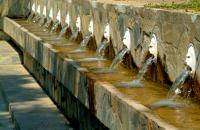 The mountain town of Spili is slightly overrated. Its famous and surprising Venetian fountain is the main reason why people come there. This was the reason why we went.
The mountain town of Spili is slightly overrated. Its famous and surprising Venetian fountain is the main reason why people come there. This was the reason why we went.
The fountain, pictured below, features nineteen white/cream lion heads spurring water into a narrow canal. It was a peculiar fountain, but it looked great. I wonder who designed it. All the lion heads were identical and the fountain was slightly larger than the photograph suggests. I just could not capture it all. I stood there for a while and tried to guess whether the fountain was supposed to be more than just a decoration and perhaps serve some practical purpose. Hmm... It could potentially serve as an easy water source for the inhabitants.
We did not necessarily regret it, but the town lacked the wow factor. There was nothing else to see or do in this small town. The streets were empty and people looked unhappy to me. I doubt my friends actually remember the place at all.
By the fountain we had some ice-cream and a quick drink and the town failed to impress us much. I know that there was a number tourist buses stopping at the fountain briefly and rushing away from this supposedly attractive place.
We did not linger too long in Spili either. After the car accident, we wanted to catch up with our plan and there was yet another place we wished to have a quick look at, before we made our way to Chania for the night. If we took is slow and explored it a little more, maybe we would have found that Spili was nice and welcoming. I do not know.
Well, we went back to the car and drove father south-west. The afternoon shadows kept getting longer as the sun was lowering itself towards the horizon. It was an optical illusion, because we were in the mountains, but it was time for us to proceed quickly. Rapid calculations of the time against kilometres to make suggested that we should still be able to see Agia Galini, a small coastal town, which was raved about in many guidebooks.
|
Oct 01, 2003 02:00 PM Crete (GR) - Agia Galini
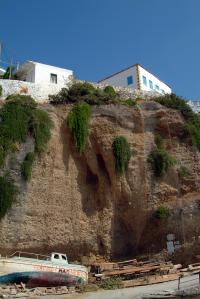 I am sorry for the inhabitants of Agia Galini for what I am about to say about this place. Sadly, the town is not what it is described in the tourist literature. Its harbour is simply a cement dumping spot and I could not find anything remotely attractive in the beach.
I am sorry for the inhabitants of Agia Galini for what I am about to say about this place. Sadly, the town is not what it is described in the tourist literature. Its harbour is simply a cement dumping spot and I could not find anything remotely attractive in the beach.
The high cliffs make the town attractively located but the number of tourists make it uncomfortably overcrowded and the number of hotels per square meter of the town’s area is off-putting.
When we arrived, we struggled to keep ourselves busy there. I could not understand what was so attractive about Agia Galini that all those tourists kept pouring there.
I heard about its reputation of 340 days of sunshine a year, and yet there must be other places in the vicinity that can claim the same. And they must be more attractive than Agia Galini. That cannot possibly be hard at all.
We stopped for a quick meal there. Picture this: We could not find an attractive setting along the beach, so we sat at one of the restaurants, perhaps close to the water. Yet our table was placed in the front of a car park. Between our table and the waters’ edge, there must have been a hundred or two hundreds of vehicles. Including our rental one!
We shoved up our late lunch, which was not good at all, and jumped back into a car to get away from there as fast as we could.
To prove my point, the picture above shows a fragment of the seafront at Agia Galini. Is it not clear to see how messy it is!?
|
Oct 01, 2003 02:00 PM Crete (GR) - Rethymno
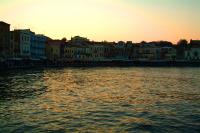 Kept in a very similar style like Chania, Rethymno is smaller, yet has a very similar ambiance and the same quality of the Venetian harbour filled with restaurants specialising with seafood. Restaurants here were more persuasive in inviting tourists to try their food. Well, as they were more tightly packed around the circular old port, the competition must have been more intense. Because of that, the port looked much smaller compared with the one in Chania. However, I think that the circular section of both was almost equal in size, as they both are about 100 meters across. This one in Rethymno had a more regular shape, though.
Kept in a very similar style like Chania, Rethymno is smaller, yet has a very similar ambiance and the same quality of the Venetian harbour filled with restaurants specialising with seafood. Restaurants here were more persuasive in inviting tourists to try their food. Well, as they were more tightly packed around the circular old port, the competition must have been more intense. Because of that, the port looked much smaller compared with the one in Chania. However, I think that the circular section of both was almost equal in size, as they both are about 100 meters across. This one in Rethymno had a more regular shape, though.
An extra quality of Rethymno is its vast Venetian fort right by the waterfront and a number of minarets sticking out all over the old quarter adding an interesting Oriental flavour to the already pretty picture. The town has its own character despite obvious similarities to Chania. The architecture is again unmistakably Venetian. And great!
We did not stay in Rethymno for very long - just an evening, night and morning. I actually did not take many pictures there at all, which I find extremely surprising!
|
Sep 30, 2003 02:00 PM Crete (GR) - Moni Toplou
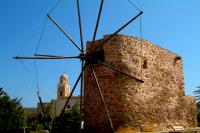 The other monastery we saw was Moni Toplou. I liked it much more, because it has a tighter architecture, larger church and gardens. It looks like more like a monastery, because it resembles a fort actually. Many true monasteries do. The harder to get to them, the better. Right?
The other monastery we saw was Moni Toplou. I liked it much more, because it has a tighter architecture, larger church and gardens. It looks like more like a monastery, because it resembles a fort actually. Many true monasteries do. The harder to get to them, the better. Right?
This one played its defensive role well. It was a military target of the Knights of St John, Venetians and Turks.
The most attractive feature of it was this garden that I mentioned. In the garden a stone windmill stood. It was this simple structure-machine that took some space on my camera’s memory card.
I am not sure what it was about it, but I could not get my eyes off it. I have no idea what it was used for, but I did not particularly care. I just wanted to take pictures of it. It was well preserved, and my guess was that it was fully operational not long ago.
|
Page:
 98 99 100 101 102 103 104 105 106 107 108
98 99 100 101 102 103 104 105 106 107 108

|
|
|
